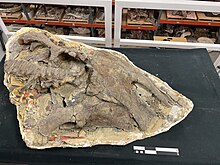阿纳萨齐龙属
| 阿纳萨齐龙属 化石时期:
| |
|---|---|

| |
| 科学分类 | |
| 界: | 动物界 Animalia |
| 门: | 脊索动物门 Chordata |
| 纲: | 蜥形纲 Sauropsida |
| 总目: | 恐龙总目 Dinosauria |
| 目: | †鸟臀目 Ornithischia |
| 亚目: | †鸟脚亚目 Ornithopoda |
| 科: | †鸭嘴龙科 Hadrosauridae |
| 亚科: | †栉龙亚科 Saurolophinae |
| 属: | †阿纳萨齐龙属 Anasazisaurus Hunt and Lucas, 1993 |
| 模式种 | |
| 霍纳氏阿纳萨齐龙 Anasazisaurus horneri Hunt and Lucas, 1993
| |
阿纳萨齐龙属(学名:Anasazisaurus)是种鸟脚亚目鸭嘴龙科恐龙,生存于晚白垩纪,约7400万年前。化石发现于美国新墨西哥州圣胡安县的嘉德兰组,目前只发现一个部分颅骨。这个化石最初被杰克·霍纳(Jack Horner)归类于小贵族龙。阿纳萨齐龙的著名处在于鼻部上的短头冠,从两眼中间往头后延伸。
叙述
[编辑]阿纳萨齐龙的生理特征资讯不多。牠们的颅骨保存状态差,缺乏下颌、喙嘴、与方骨,而且直到近年才完全重建好[1]。阿纳萨齐龙的鼻骨上有突出骨头,从两眼中间开始,向头后方延伸。这种独特头冠与其相近物种格里芬龙不同[2]。头冠顶端为圆形,而颅骨的长度为90公分以内[1]。
分类
[编辑]阿纳萨齐龙属于栉龙亚科,因为牠们缺乏内部中空的头冠。最近的研究认为,阿纳萨齐龙在鸭嘴龙亚科中占了独特的演化位置[3]。如果阿纳萨齐龙与小贵族龙是同种动物,较早命名的小贵族龙将具有优先权。
历史
[编辑]正模标本(编号BYU 12950)是一个颅骨,也是目前唯一的标本,是在70年代晚期,由杨百翰大学的田野工作团队在新墨西哥州的圣胡安县发现。在1993年,美国古生物学家阿德里安·亨特(Adrian Hunt)与史宾赛·卢卡斯(Spencer G. Lucas)建立了霍纳氏阿纳萨齐龙(A. horneri),也是目前唯一的种。属名是以古代美洲原住民阿纳萨齐人为名,阿纳萨齐人因他们的悬崖住所而著名,化石发现地附近的厦谷文化国家历史公园有很多这种悬崖住所。种名则是以著名古生物学家杰克·霍纳(Jack Horner)为名,他在1992年先叙述了这个化石[4]。
阿纳萨齐龙是否为有效的属,还有争论。在1992年,杰克·霍纳最初将这个颅骨归类于小贵族龙[2]。在第二年,亨特与卢卡斯认为小贵族龙的有限化石,无法德出任何识别的特征,因此将小贵族龙列为疑名。而这个颅骨具有独特、可辨识的特征,而且与小贵族龙之间没有显著的相同特征,因此亨特与卢卡斯将牠们独立为新属,霍纳氏阿纳萨齐龙。 [4]大部分最近的研究,都支持这个决定[3]。但是一些科学家仍主张阿纳萨齐龙与小贵族龙是同种动物,包含曾做过最详细检验的汤玛斯·威廉森(Thomas Williamson)[5]。阿纳萨齐龙目前只有一个颅骨,需要更多的化石,才能了解阿纳萨齐龙与小贵族龙的分类关系。
古生态学与古生物学
[编辑]阿纳萨齐龙的化石发现于嘉德兰组的下层。嘉德兰组的年代为晚白垩纪的晚坎潘阶,约7400万年前[5]。该地层发现的其他恐龙有:阿拉莫龙、五角龙、结节头龙、蜥鸟盗龙、以及一种未命名的暴龙科恐龙[6]。
如同其他鸭嘴龙类,阿纳萨齐龙是种大型、二足、草食性恐龙,头部构造复杂,下颌可以做出类似咀嚼的研磨动作。牠们有数百颗牙齿,形成齿系(Dental batteries),会不断成长、更换,同一时间只会使用少部分牙齿。牠们会用喙嘴切断植物,并将食物置于两旁的颊囊中。牠们以离地面四米以下的植物为食[3]。
参考资料
[编辑]- ^ 1.0 1.1 Lucas, Spencer G.; Spielman, Justin A.; Sullivan, Robert M.; Hunt, Adrian P.; and Gates, Terry. Anasazisaurus, a hadrosaurian dinosaur from the Upper Cretaceous of New Mexico. Lucas, S.G.; and Sullivan, Robert M. (eds.) (编). Late Cretaceous Vertebrates from the Western Interior. New Mexico Museum of Natural History and Science Bulletin, 35. Albuqueque, New Mexico: New Mexico Museum of Natural History and Science. 2006: 293–297.
- ^ 2.0 2.1 Horner, John R. Cranial morphology of Prosaurolophus (Ornithischia: Hadrosauridae) with descriptions of two new hadrosaurid species and an evaluation of hadrosaurid phylogenetic relationships. Museum of the Rockies Occasional Paper. 1992, 2: 1–119.
- ^ 3.0 3.1 3.2 Horner, John R.; Weishampel, David B.; and Forster, Catherine A. Hadrosauridae. Weishampel, David B.; Dodson, Peter; and Osmólska, Halszka (eds.) (编). The Dinosauria 2nd. Berkeley: University of California Press. 2004: 438-463. ISBN 0-520-24209-2.
- ^ 4.0 4.1 Hunt, Adrian P.; and Lucas, Spencer G. Cretaceous vertebrates of New Mexico. Lucas, S.G.; and Zidek, J. (eds.) (编). Dinosaurs of New Mexico. New Mexico Museum of Natural History and Science Bulletin, 2. Albuqueque, New Mexico: New Mexico Museum of Natural History and Science. 1993: 77–91.
- ^ 5.0 5.1 Williamson, Thomas E. Review of Hadrosauridae (Dinosauria, Ornithischia) from the San Juan Basin, New Mexico. Lucas, S.G.; and Heckert, A.B. (eds.) (编). Dinosaurs of New Mexico. New Mexico Museum of Natural History and Science Bulletin, 17. Albuqueque, New Mexico: New Mexico Museum of Natural History and Science. 2000: 191–213.
- ^ Weishampel, David B.; Barrett, Paul M.; Coria, Rodolfo A.; Le Loeuff, Jean; Xu Xing; Zhao Xijin; Sahni, Ashok; Gomani, Elizabeth, M.P.; and Noto, Christopher R. (2004). "Dinosaur Distribution". The Dinosauria (2nd). 517–606.








